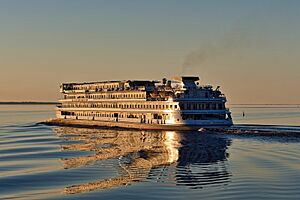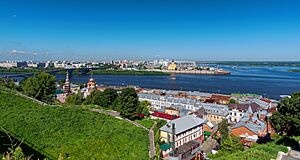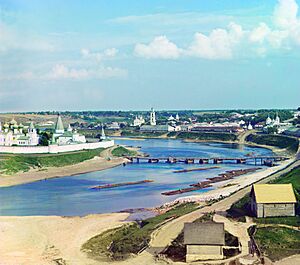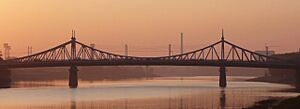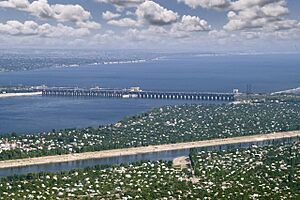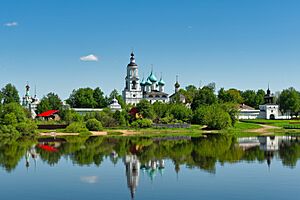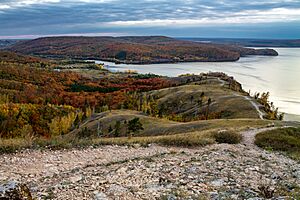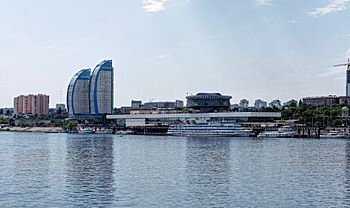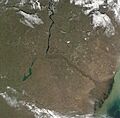Volga facts for kids
Quick facts for kids Volga |
|
|---|---|

The Volga at Yaroslavl
|
|
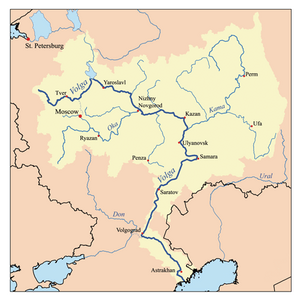
Map of the Volga drainage basin
|
|
| Location | Eastern Europe |
| Country | Russian Federation |
| Cities | Tver, Yaroslavl, Nizhny Novgorod, Cheboksary, Kazan, Ulyanovsk, Samara, Saratov, Volgograd, Astrakhan, Togliatti |
| Physical characteristics | |
| Main source | Valdai Hills, Tver Oblast 228 m (748 ft) 57°15′4.7″N 32°28′5.1″E / 57.251306°N 32.468083°E |
| River mouth | Caspian Sea Astrakhan Oblast −28 m (−92 ft) 45°41′42″N 47°53′51″E / 45.69500°N 47.89750°E |
| Length | 3,531 km (2,194 mi) |
| Discharge (location 2) |
8,228.298 m3/s (290,579.6 cu ft/s)
|
| Discharge (location 3) |
7,785.921 m3/s (274,957.2 cu ft/s) |
| Discharge (location 4) |
2,806.467 m3/s (99,109.4 cu ft/s) Yaroslavl (Basin size: 153,657.8 km2 (59,327.6 sq mi): 1,008.277 m3/s (35,607.0 cu ft/s) Rybinsk (Basin size: 150,119.8 km2 (57,961.6 sq mi): 993.253 m3/s (35,076.4 cu ft/s) |
| Discharge (location 5) |
186.157 m3/s (6,574.1 cu ft/s) |
| Basin features | |
| Basin size | 1,360,000 km2 (530,000 sq mi) 1,404,107.6 km2 (542,129.0 sq mi) |
| Tributaries | |
The Volga (Russian: Волга) is the longest river in Europe. It is located in Russia and flows through Central Russia to Southern Russia. The river then empties into the Caspian Sea.
The Volga is about 3,531 km (2,194 mi) long. Its basin, the area of land that drains into it, covers 1,360,000 km2 (530,000 sq mi). It is also Europe's largest river in terms of how much water flows through it. This is called its average discharge. The Volga is often called the national river of Russia.
The river flows through different types of land in Russia. These include forests, forest steppes, and steppes. Many large cities in Russia are in the Volga's drainage basin. This includes Moscow, the nation's capital. The Volga flows into the Caspian Sea, which is a closed body of water. This means the Volga does not naturally connect to any of the world's oceans.
Some of the biggest reservoirs in the world are built along the Volga River. The river is very important in Russian culture. People often call it Волга-матушка Volga-Matushka, which means "Mother Volga".
Contents
The Name of the Volga River

The Russian name for the river, Volga, comes from an old Slavic word. This word, *vòlga, meant 'wetness' or 'moisture'. You can still see this meaning in many Slavic languages today. For example, in Russian, vlaga means 'moisture'.
Ancient people called the Scythians lived near the Volga. They called the river Rahā, which also meant 'wetness'. This name is related to old words for 'wet' or 'moisture'.
The Greek writer Herodotus wrote about two other old names for the Volga. One was Oarus, meaning "broad". The other was Araxes.
Turkic peoples who lived along the river used to call it Itil or Atil. Today, in different Turkic languages, it has similar names. For example, in Tatar it is İdel, and in Chuvash it is Atăl. These names might come from an old Turkic word.
Some Turkic peoples thought the Volga started from the Kama river. They even named a tributary of the Kama the White Itil. The Mari, another group, call the river Jul, which means 'way' in Tatar.
About the Volga River
The Volga is the longest river in Europe. Almost all of its drainage basin is inside Russia. It flows into the Caspian Sea, which is a closed basin. This makes the Volga the longest river to flow into a closed basin.
The Volga starts in the village of Volgoverkhov'e in Tver Oblast. It begins in the Valdai Hills, about 225 meters (738 ft) above sea level. This is northwest of Moscow. The river flows east past cities like Tver, Yaroslavl, and Kazan. Then it turns south, flowing past Samara and Volgograd. Finally, it empties into the Caspian Sea near Astrakhan. The mouth of the river is 28 meters (92 ft) below sea level.
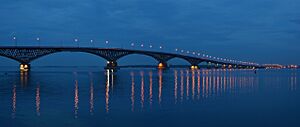
The Volga has many smaller rivers that flow into it. These are called tributaries. The most important ones are the Kama, the Oka, the Vetluga, and the Sura. The Volga and its tributaries form a large river system. This system covers about 1,350,000 square kilometres (521,238 square miles) of land. This area is the most populated part of Russia.
The Volga Delta is where the river spreads out into many channels before reaching the sea. It is about 160 kilometres (99 miles) long and has about 500 channels. This delta is the largest estuary in Europe. It is the only place in Russia where you can find pelicans, flamingos, and lotus flowers. The Volga freezes for about three months each year along most of its length.
The Volga is very important for irrigation and hydroelectric power. Many large reservoirs have been built on it. Canals connect the Volga to other seas. The Moscow Canal connects Moscow to the Volga. The Volga–Don Canal connects it to the Black Sea. The Volga–Baltic Waterway links it to the Baltic Sea and White Sea. This means ships can travel from Moscow to many different seas. However, high levels of chemical pollution have harmed the river and its wildlife.
The fertile valley around the Volga is good for growing wheat and other crops. It also has many valuable minerals. There is a large oil industry in the Volga valley. Other resources found here include natural gas, salt, and potash. The Volga Delta and the Caspian Sea are important fishing grounds.
Rivers Joining the Volga (Downstream to Upstream)
- Akhtuba (near Volzhsky)
- Bolshoy Irgiz (near Volsk)
- Samara (in Samara)
- Kama (south of Kazan)
- Kazanka (in Kazan)
- Sviyaga (west of Kazan)
- Vetluga (near Kozmodemyansk)
- Sura (in Vasilsursk)
- Kerzhenets (near Lyskovo)
- Oka (in Nizhny Novgorod)
- Uzola (near Balakhna)
- Unzha (near Yuryevets)
- Kostroma (in Kostroma)
- Kotorosl (in Yaroslavl)
- Sheksna (in Cherepovets)
- Mologa (near Vesyegonsk)
- Kashinka (near Kalyazin)
- Nerl (near Kalyazin)
- Medveditsa (near Kimry)
- Dubna (in Dubna)
- Shosha (near Konakovo)
- Tvertsa (in Tver)
- Vazuza (in Zubtsov)
- Selizharovka (in Selizharovo)
Reservoirs Along the Volga
Many large hydroelectric reservoirs were built on the Volga during the Soviet era. These include:
- Volgograd Reservoir
- Saratov Reservoir
- Kuybyshev Reservoir – the largest in Europe by surface area
- Cheboksary Reservoir
- Gorky Reservoir
- Rybinsk Reservoir
- Uglich Reservoir
- Ivankovo Reservoir
Major Cities on the Volga's Banks
- Kazan
- Nizhny Novgorod
- Samara
- Volgograd
- Saratov
- Tolyatti
- Yaroslavl
- Astrakhan
- Ulyanovsk
- Cheboksary
- Tver
History of the Volga River Region
People have lived in the Volga–Oka region for at least 9,000 years. They used bone and antler to make tools like arrowheads and knives.
In ancient times, the Volga was a border between different groups. These included the Cimmerians and the Scythians. Later, the Alans settled in the Middle Volga region.
Many different groups lived around the Volga in the first thousand years AD. These included Slavic tribes, Finno-Ugric peoples, Scandinavians, and Turkic peoples. The river was also important for trade with the Byzantine Empire. The ancient scholar Ptolemy called the lower Volga the Rha.
The Volga basin was important for people moving from Asia to Europe. The powerful Volga Bulgaria kingdom grew where the Kama joins the Volga. The Khazaria kingdom controlled the lower parts of the river. Cities like Atil and Sarai were major centers in the Middle Ages. The Volga was a key trade route. It connected Scandinavia and Finnic areas with Slavic, Turkic, and other peoples. It also linked these areas to Khazaria, Persia, and the Arab world.
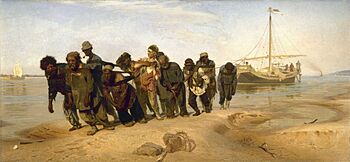
Later, the Golden Horde took control of the lower Volga. Their empire split into the Khanate of Kazan and Khanate of Astrakhan. Russia conquered both of these in the 16th century. The Russian people have a deep connection to the Volga. This feeling is shown in their culture and literature. The song "The Volga Boatman's Song" is one example.
Building dams in the Soviet Union often meant many people had to move. Historical sites were also lost. For example, the town of Mologa was flooded to create the Rybinsk Reservoir. This reservoir was once the largest artificial lake in the world.
Conflicts in the 20th Century

The Volga River played a role in several conflicts. During the Russian Civil War, both sides used warships on the Volga. In 1918, the Red Volga Flotilla helped push the White forces eastward.
During World War II, the city of Volgograd (then called Stalingrad) saw the Battle of Stalingrad. This was one of the bloodiest battles in history. The Soviet Union and German forces fought fiercely for control of the river. The Volga was a vital transport route. It connected central Russia to the Caspian Sea, which had access to oil fields.
Controlling the river meant being able to move soldiers and supplies. Hitler wanted to use the oil fields to help Germany's war efforts. By taking the river, Germany could also stop the Soviet Union from using this important route. This would cut off their access to oil and supplies. Because of this, many military attacks happened to gain control of the river banks.
People of the Volga Region
Many different groups of people have lived along the Volga River. The Eastern Slavic Vyatchi tribes were important in forming modern Russians. Some of the first people along the upper Volga were the Finnic Mari and Merya people.
Since ancient times, the Volga was a key trade route. Not only Slavic, Turkic, and Finnic peoples lived there, but also traders from the Arab world and Varangian people from Nordic countries. In the 8th and 9th centuries, people from Kievan Rus' began to settle there. They brought Christianity to the upper Volga. Some local non-Slavic people became Christian and slowly became East Slavs.
The Maris, Erzyas, and Mokshas are examples of Volga Finnic groups still living in the middle Volga region. Also, Khazar and Bulgar peoples lived in the Volga River basin.
The first Turkic tribes arrived in the 7th century. They mixed with some Finno-Ugric and Indo-European people. The Chuvash (who are Christian) and Volga Tatars (who are Muslim) are descendants of the people from medieval Volga Bulgaria. Another Turkic group, the Nogais, used to live in the lower Volga steppes.
The Volga region is also home to a German minority group, the Volga Germans. Catherine the Great invited foreigners to settle the region in 1763. She offered them many benefits. Germans came in large numbers because of conditions in their home country. They helped develop the region and created a buffer zone. During the Soviet Union, part of the region became the Volga German Autonomous Soviet Socialist Republic.
The Volga is very important for shipping and transport in Russia. Large dams were built on the river during the time of Joseph Stalin. These dams made the river wider for navigation. All the dams have big ship locks. This allows large ships to travel almost the entire length of the river from the Caspian Sea.
The Volga is connected to the Don and the Black Sea by the Volga–Don Canal. It is also connected to northern lakes like Lake Ladoga and Lake Onega. The Volga–Baltic Waterway links it to Saint Petersburg and the Baltic Sea. The Moscow Canal connects the Volga to the Moskva River and Moscow.
This system of waterways is designed for large ships. It covers thousands of kilometers. Many companies operate passenger and cargo ships on the river. Volgotanker, for example, has over 200 petroleum tankers.
In recent times, grain and oil have been the biggest goods transported on the Volga. For a long time, foreign ships had very limited access to Russian waterways. But new policies are changing this. Soon, ships from other countries are expected to be allowed on Russian rivers.
Images for kids
-
View of the river and Volgograd from space.
Cultural Significance
Literature
- Without a Dowry, The Storm – dramas by the Russian playwright Aleksandr Ostrovsky
- In the Forests, On the Hills – novels by Pavel Melnikov
- Yegor Bulychov and Others, Dostigayev and Others – plays by Maxim Gorky
- "Distance After Distance" – poem by Aleksandr Tvardovsky
- "On the Volga" – a poem by Nikolay Nekrasov
- "Volga and Vazuza" – a poem by Samuil Marshak
- The Precipice – a novel by Ivan Goncharov
- Volga Se Ganga - a novel by Hindi language writer Rahul Sankrityayan
Cinema
- Volga-Volga (1938) – a Soviet film comedy directed by Grigori Aleksandrov
- Ekaterina Voronina (1957) – Soviet drama film directed by Isidor Annensky
- The Bridge Is Built (1965) – a Soviet film about the construction of a road bridge across the Volga in Saratov by Oleg Efremov and Gavriil Egiazarov
- A Cruel Romance (1984) – romantic drama directed by Eldar Ryazanov
- Election Day (2007) – Russian comedy film directed by Oleg Fomin
Music
- The Song of the Volga Boatmen
Video Games
- Metro Exodus – Volga is one of main levels of the game
See also
 In Spanish: Volga para niños
In Spanish: Volga para niños
- Caspian Depression
- List of rivers of Russia


